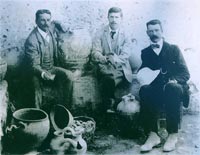 ARCHAEOLOGICAL SITE OF KNOSSOS
ARCHAEOLOGICAL SITE OF KNOSSOS
The Minoan palace is the main site of Knossos, an important city in ancient times, livable continuously from the Neolithic period to the 5th century AD. It is built on the hill of Kefala, and has an easy access to the sea and to the inner of Crete. According to tradition, it was the seat of the wise King Minoas. Exciting myths, as these of the Labyrinth with the Minotaur and of the Daedalus and Icarus, are connected with the palace of Knossos.

The first excavations were conducted in 1878 by Minos Kalokerinos. Those were followed by excavations that were carried out by the Englishman Sir Arthur Evans (1900-1913 and 1922-1930) that revealed the entire palace.
The oldest traces of habitation in the area of the palace date back to the Neolithic period (7000-3000 BC). The occupation continued in the Pre palace period (3000-1900 BC), after which the area was leveled for a large palace to be build. The first palace was destroyed, probably by an earthquake in about 1700 BC.
The second, and the most magnificent, palace was built on the ruins of the old one. After its partial destruction, around 1450 BC, Mycenaeans settled in Knossos. The palace was finally destroyed about 1350 BC by fire. The area occupied again from the late Mycenaean period to Roman times.

Large-scale restorations of the palace of Knossos have been made by the archaeologist Sir Arthur Evans. It was a multi-storey building, covering an area of 20,000 sq.m. Impressive is the variety of the building materials, the painted plaster, the marble revetment and the wall paintings that decorate the rooms and the corridors.
The advanced technical knowledge of the Minoans is confirmed by the original architectural and structural features, such as the skylights and the multi-doors, the utilization of beams to reinforce the wall and the complex drainage and water supply network.